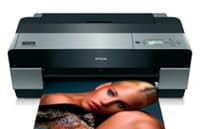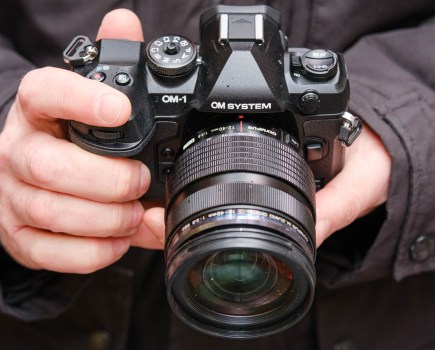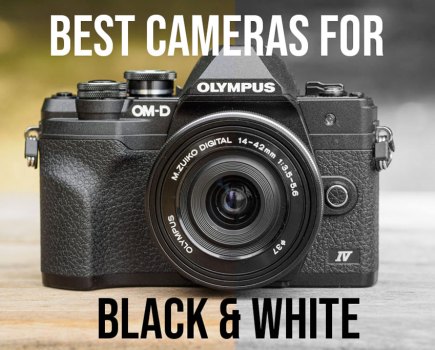A3 printers
 Canon Pixma Pro 9000 Mark II
Canon Pixma Pro 9000 Mark II
Price: £359
The Pixma Pro 9000 Mark II uses eight ChromaLife 100 dye-based inks, comprising cyan, magenta, yellow, photo cyan, photo magenta, red, green and black, each in a separate cartridge. With just one black ink, this printer is a better option for colour rather than monochrome prints. The results on glossy media are especially impressive.
As the FINE print head produces droplets with a minimum volume of 2pl at a resolution of 4800x2400dpi, prints have plenty of detail. This and the 48-bit printing also ensure that gradations are nice and smooth.
Print size may be varied from 10x15cm up to A3+ and 35.56cm (14in) wide, with gloss, matte, canvas and board media being supported. Although a plug-in enables Canon DSLR users to print raw files direct from Adobe Photoshop, they also have the option print direct from the Digital Photo Pro (DPP) software supplied with their camera.
Printing times vary depending upon whether a colour or monochrome print is being made, but range from around 3 minutes 15 seconds for a colour A3 print, and about 16 minutes 15 seconds for monochrome.
 Canon Pixma Pro 9500 Mark II
Canon Pixma Pro 9500 Mark II
Price: £539
Although it is outwardly almost identical to the Pixma Pro 9000 Mark II, the Pixma Pro 9500 Mark II uses Canon’s Lucia pigment-based inkset.
It has ten inks in individual cartridges and has grey and photo black in addition to cyan, magenta, yellow, photo cyan, photo magenta, red, green and black.
The grey and photo black inks improve the Pixma Pro 9500 Mark II’s monochrome performance, extending the range of tones that it can reproduce in its greyscale mode. However, we found that the blacks in prints made on matte paper tend to be dark charcoal-grey rather than absolute black.
The nozzles of printers using pigment ink tend to be larger, so it’s no surprise that the minimum droplet size delivered by the FINE print head of the Pixma Pro 9500 Mark II is 3pl rather than the 2pl of the Pixma Pro 9000 Mark II. However, the 9500 Mark II has the same maximum resolution as the 9000 Mark II (4800x2400dpi) and the results have lots of detail.
Colour and black & white prints are produced in about the same length of time, with a best-quality
A3 print taking around 8 minutes 15 seconds.
As with the 9000, Windows Vista users can also benefit from the Ambient Light Correction feature that automatically adjusts the colours so they appear correct in different lighting conditions.
 Epson Stylus Photo R2880
Epson Stylus Photo R2880
Price: £598.99
The stylus Photo R2880 is Epson’s top-of-the range A3 printer for photographers. It uses Epson’s UltraChrome K3+ inkset with nine cartridges containing photo black or matte black, light black, light light black, cyan, vivid magenta, yellow, light cyan, light magenta.
The drawback is that the R2880 only has eight ink channels, so the photo black and matte black must be swapped around depending upon the print media. The pay-off, however, is that the printer can produce excellent colour and monochrome images on a range of different paper types.
With a minimum droplet size of 3pl, the R2880 cannot produce droplets as fine as the R1900 (below) or 1400 (bottom), but it still does an excellent job with gradations and fine details, and prints at a maximum resolution of 5760x134dpi. An A3+ print takes just over 10 minutes.
Using three shades of black (or grey) means the R2880 produces excellent black & white prints. The ability to shift an image’s white point to very light grey can be useful with images that have large sections of very light tone, but it is at the expense of pure white, which may seem anathema to some.
 Epson Stylus Photo R1900
Epson Stylus Photo R1900
Price: £349.99
An extra £50 on top of the price of the Stylus Photo 1400 (below) brings a switch to Epson’s UltraChrome Hi-Gloss 2 pigment-based inkset.
In addition to the standard array of cyan, magenta and yellow inks, the R1900 uses red, orange, photo black and matte black ink, with an eighth tank being used for a gloss optimiser. The latter gives prints made on glossy paper an even lustre even where no ink has been laid down.
Like the 1400, the Stylus Photo R1900 has a minimum droplet size of 1.5pl, but there are 1,440 nozzles on the Micro-Piezo print head, giving 180 per colour. The minimum droplet size is especially impressive given that the R1900 uses pigment inks, which tend to require larger nozzles that mean bigger droplets.
Despite using pigment-based inks, the R1900 produces vibrant prints with plenty of detail. Mono prints don’t appear unduly hampered by the presence of just one black ink for each media and are very respectable.
With the highest quality settings selected, an A3 print takes around 9 minutes to emerge from the R1900.
 Epson Stylus Photo 1400
Epson Stylus Photo 1400
Price: £299.99
Printers tend to have a longer shelf life than cameras, and although we first tested Epson’s Stylus Photo 1400 in AP 21 April 2007, it is still a current model and represents good value for money.
It uses six dye-based Claria inks (black, cyan, magenta, light cyan, light magenta and yellow) in separate cartridges with 90 nozzles on the Micro-Piezo print head for each colour. At just 1.5pl, its minimum droplet size is the same as the Epson Stylus Photo R1900’s. This combines with an impressive maximum printing resolution of 5750x1440dpi, which enables the 1400 to produce smooth gradations and reproducing fine details.
Epson claims that prints made on its Ultra Glossy, Premium Glossy, Premium Semigloss and Archival Matte papers with its Claria inks should resist fading for up to 200 years when stored in an album.
Although the 1400 produces prints of excellent quality, they change significantly after a few hours’ drying time.
It’s worth waiting to assess the fully cured results before making any adjustments to the image colour. Even after drying, mono prints tend to have some form of colour cast, so this is not the best printer for those wishing to make pure black & white prints.
You can expect to wait around 9 minutes for an A3-sized print to be ejected from the 1400, whether
it is colour or monochrome.
A2 printers
 Epson Stylus Photo Pro 3880
Epson Stylus Photo Pro 3880
Price: £973
Epson’s Stylus Photo Pro 3880 is the big brother of the Stylus Photo R2880 (see page 47) and can make prints of up to A2+ or 17×37.4in in size.
It uses the same UltraChrome K3+ inkset as its smaller compatriot, but all nine inks can be accommodated at the same time and they each contain 80ml of liquid rather than the 11.4ml found in the R2880’s tanks.
As well as doing away with the need to swap the matte black and photo black cartridges, economy
of scale means that comparably sized prints costs considerably less than they would if they were made using the A3+ printer. Nevertheless, shelling out for cartridges that cost an average of around £47 each isn’t to be taken lightly.
Although it uses the same inkset as the R2880, there are a few differences with the 3880. Its minimum droplet size, for example, is a little larger at 3.5pl and the maximum printing resolution is lower at 2880x1440dpi. We found the drop in resolution is just noticeable, but given that the 3880 is likely to be used to make larger prints that usually demand a greater viewing distance, in practice it is unlikely to be much of an issue.
Unlike many of Epson’s high-end printers, the 3880 cannot accept rolls of paper, only sheets
In comparison to the Canon imagePROGRAF iPF5100 (see below), the Stylus Photo Pro 3880 is quite trim, but it still takes up 550x684x1040mm when the paper feed and receiver are ready for action.
With a printing time of around 11 minutes for an A2 print, the 3880 doesn’t keep you hanging around too long. That’s around a minute faster than the iPF5100 takes.
 Canon imagePROGRAF iPF5100
Canon imagePROGRAF iPF5100
Price: £1,649
Canon’s imagePROGRAF iPF5100 is an A2 printer, but it can print onto rolls of paper that are up to 17in wide and prints can be considerably longer than A2.
In fact, their length is really only constrained by the limits of file handling. A cutter is built in so the paper can be trimmed to the ideal length for the print. These factors make the iPF5100 a great choice for photographers who want to produce large panoramas.
This printer uses 12 inks, the largest number of inks of any printer here, comprising cyan, magenta, yellow, photo cyan, photo magenta, red, green, blue, black, matte black, grey and photo grey.
All the cartridges, which contain 130ml of ink, are used in the printer at the same time, so there’s no swapping of tanks depending upon the print media. At £65 each, which means each litre of ink costs £500, buying a complete set of inks isn’t for the faint-hearted.
Those who like to keep careful records or who want to charge for prints will love the fact that the iPF5100 measures the amount of ink that it uses for each print, and that this information can be retrieved to enable print costs to be calculated.
I found that an A2 print uses 3.4ml of ink, which costs £1.70.
Although the colour and monochrome results from the iPF5100 are excellent, it is worth noting that its two print heads deliver a print resolution of 2,400×1,200dpi at a constant droplet size of 4pl. This is a lower resolution and larger droplet size than the Epson 3880 uses.
The main problem with the iPF5100 is its sheer bulk. It is 132cm (4ft 4in) wide, which is roughly twice the width of the paper it accepts. There is an optional stand available, and printing from a roll removes the need for a paper feed-tray, but you still have to find room space for it.







